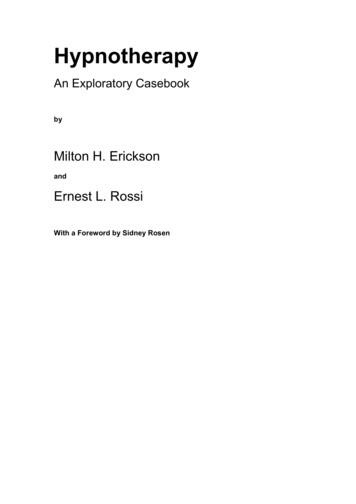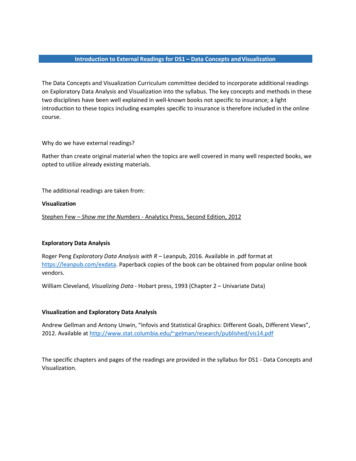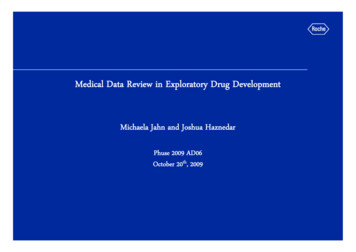
Transcription
HypnotherapyAn Exploratory CasebookbyMilton H. EricksonandErnest L. RossiWith a Foreword by Sidney Rosen
IRVINGTON PUBLISHERS, Inc., New YorkHalsted Press Division ofJOHN WILEY Sons, Inc.New York London Toronto SydneyThe following copyrighted material is reprinted by permission:Erickson, M. H. Concerning the nature and character of post-hypnotic behavior.Journal of General Psychology, 1941, 24, 95-133 (with E. M. Erickson). Copyright 1941.Erickson, M. H. Hypnotic psychotherapy. Medical Clinics of North America, NewYork Number, 1948, 571-584. Copyright 1948.Erickson, M. H. Naturalistic techniques of hypnosis. American Journal of ClinicalHypnosis, 1958, 1, 3-8. Copyright 1958.Erickson, M. H. Further clinical techniques of hypnosis: utilization techniques.American Journal of Clinical Hypnosis, 1959, 2, 3-21. Copyright 1959.Erickson, M. H. An introduction to the study and application of hypnosis for paincontrol. In J. Lassner (Ed.), Hypnosis and Psychosomatic Medicine: Proceedings oftheInternational Congress for Hypnosis and Psychosomatic Medicine. Springer Verlag,1967. Reprinted in English and French in the Journal of the College of GeneralPractice of Canada, 1967, and in French in Cahiers d' Anesthesiologie, 1966, 14,189-202. Copyright 1966, 1967.Copyright 1979 by Ernest L. Rossi, PhDAll rights reserved. No part of this book may be reproduced in any manner whatever, includinginformation storage or retrieval, in whole or in part (except for brief quotations in critical articles orreviews), without written permission from the publisher. For information, write to Irvington Publishers,Inc., 551 Fifth Avenue, New York, New York 10017.Distributed by HALSTED PRESSA division of JOHN WILEY SONS, Inc., New YorkLibrary of Congress Cataloging in Publication DataErickson, Milton H. Hypnotherapy, an exploratory casebook.Includes bibliographical references.1. Hypnotism - Therapeutic use. I. Rossi, Ernest Lawrence, joint author. II. Title. RC495.E719615.8512 78-23839 ISBN 0-470-26595-7
Printed in The United States of America
ContentsForewordPrefaceChapter 1. The Utilization Approach to Hypnotherapy1. Preparation2. Therapeutic Trance3. Ratification of Therapeutic Change Summary ExercisesChapter 2. The Indirect Forms of Suggestion1. Direct and Indirect Suggestion2. The Interspersal Approacha) Indirect Associative Focusingb) Indirect Ideodynamic Focusing3. Truisms Utilizing Ideodynamic Processesa) Ideomotor Processesb) Ideosensory Processesc) Ideoaffective Processesd) Ideocognitive Processes4. Truisms Utilizing Time5. Not Knowing, Not Doing6. Open-Ended Suggestions7. Covering All Possibilities of a Class of Responses8. Questions That Facilitate New Response Possibilitiesa) Questions to Focus Associationsb) Questions in Trance Inductionc) Questions Facilitating Therapeutic Responsiveness
9. Compound Suggestionsa) The Yes Set and Reinforcementb) Contingent Suggestions and Associational Networksc) Apposition of Oppositesd) The Negativee) Shock, Surprise, and Creative Moments10. Implication and the Implied Directive a) The Implied Directive11. Binds and Double Bindsa) Binds Modeled on Avoidance-Avoidance and Approach-Approach Conflictsb) The Conscious-Unconscious Double Bindc) The Double Dissociation Double Bind12. Multiple Levels of Meaning and Communication: The Evolution ofConsciousness in Jokes, Puns, Metaphor, and Symbol ExercisesChapter 3. The Utilization Approach: Trance Induction and Suggestion1. Accepting and Utilizing the Patient's Manifest Behavior2. Utilizing Emergency Situations3. Utilizing the Patient's Inner Realities4. Utilizing the Patient's Resistances5. Utilizing the Patient's Negative Affects and Confusion6. Utilizing the Patient's Symptoms ExercisesChapter 4. Posthypnotic Suggestion1. Associating Posthypnotic Suggestions with Behavioral Inevitabilities2. Serial Posthypnotic Suggestions3. Unconscious Conditioning as Posthypnotic Suggestion4. Initiated Expectations Resolved Posthypnotically5. Surprise As a Posthypnotic Suggestion Exercises
Chapter 5. Altering Sensory-Perceptual Functioning: The Problem of Pain andComfortCase 1. Conversational Approach to Altering Sensory-Perceptual Functioning:Phantom Limb Pain and TinnitusCase 2. Shock and Surprise for Altering Sensory-Perceptual Functioning: IntractableBack PainCase 3. Shifting Frames of Reference for Anesthesia and AnalgesiaCase 4. Utilizing the Patient's Own Personality and Abilities for Pain ReliefSelected Shorter Cases: Exercises for AnalysisChapter 6. Symptom ResolutionCase 5. A General Approach to Symptomatic BehaviorSession One:Part One. Preparation and Initial Trance WorkPart Two. Therapeutic Trance as Intense Inner WorkPart Three. Evaluation and Ratification of Therapeutic ChangeSession Two: Insight and Working Through Related ProblemsCase 6. Demonstrating Psychosomatic Asthma with Shock to Facilitate SymptomResolution and InsightCase 7. Symptom Resolution with Catharsis Facilitating Personality Maturation: AnAuthoritarian ApproachCase 8. Sexual Dysfunction: Somnambulistic Training in a Rapid HypnotherapeuticApproachPart One. Facilitating Somnambulistic BehaviorPart Two. A Rapid Hypnotherapeutic Approach Utilizing . Therapeutic Symbolismwith Hand LevitationCase 9. Anorexia Nervosa Selected Shorter Cases. Exercises for AnalysisChapter 7. Memory RevivicationCase 10. Resolving a Traumatic ExperiencePart One. Somnambulistic Training, Autohypnosis, and Hypnotic Anesthesia
Part Two. Reorganizing Traumatic Life Experience and Memory RevivicationChapter 8. Emotional CopingCase 11. Resolving Affect and Phobia with New Frames of ReferencePart One. Displacing a Phobic SymptomPart Two. Resolving an Early-Life Trauma at the Source of a PhobiaPart Three. Facilitating Learning: Developing New Frames of ReferenceSelected Shorter Cases: Exercises for AnalysisChapter 9. Facilitating Potentials: Transforming IdentityCase 12. Utilizing Spontaneous Trance: An ExplorationIntegrating Left and Right Hemispheric ActivitySession 1: Spontaneous Trance and its Utilization: Symbolic HealingSession 2: Part One. Facilitating Self-ExplorationPart Two. Automatic Handwriting and DissociationCase 13. Hypnotherapy in Organic Spinal Cord Damage: New Identity ResolvingSuicidal DepressionCase 14. Psychological Shock and Surprise to Transform IdentityCase 15. Experiential Life Review in the Transformation of IdentityChapter 10. Creating Identity: Beyond Utilization Theory?Case 16. The February ManReferences
ForewordSpeak to the wall so the door may hear - Sufi saying.Everyone who knows Milton Erickson is aware that he rarely does anything without apurpose. In fact, his goal-directedness may be the most important characteristic of hislife and work.Why is it, then, that prior to writing Hypnotic Realities with Ernest Rossi (Irvington,1976) he had avoided presenting his work in book form? Why did he choose ErnestRossi to coauthor that book and the present one? And, finally, I could not help butwonder, Why did he ask me to write this foreword?Erickson has, after all, published almost 150 articles over a fifty-year period, but onlytwo relatively minor books - Time Distortion in Hypnosis, written in 1954 with L. S.Cooper, and The Practical Applications of Medical and Dental Hypnosis, in 1961with S. Hershman, MD and I. I. Sector, DDS. It is easy to understand that in hisseventies he may well be eager to leave a legacy, a definitive summing up, a finalopportunity for others to really understand and perhaps emulate him.Rossi is an excellent choice as a coauthor. He is an experienced clinician who hastrained with many giants in psychiatry - Franz Alexander, amongst others. He is aJungian training analyst. He is a prolific author and has devoted the major part of histime over the past six years to painstaking observation, recording and discussion ofErickson's work.Again, Why me? I am also a training analyst, but with a different group - theAmerican Institute of Psychoanalysis (Karen Horney). I have been a practicingpsychiatrist for almost thirty years. For almost fifteen years I have also done a greatdeal of work with disabled patients. I have been involved with hypnosis for overthirty-five years, since I first heard about Milton Erickson, who was then living inEloise, Michigan.Both Rossi and I have broad, but differing, clinical and theoretical backgrounds.Neither of us has worked primarily with hypnosis. Therefore, neither of us has avested interest in promoting some hypnotic theories of our own. We are genuinelydevoted to the goal of presenting Erickson's theories and ideas, not only topractitioners of hypnosis, but to the community of psychotherapists andpsychoanalysts which has had little familiarity with hypnosis. Towards this end, Rossiassumes the posture of a rather naive student acting on behalf of the rest of us.Margaret Mead, who also counts herself as one of his students, writes of theoriginality of Milton Erickson in the issue of The American Journal of ClinicalHypnosis dedicated to him on his seventy-fifth birthday (Mead, M. The Originality ofMilton Erickson, AJCH, Vol. 20, No. 1, July 1977, pp. 4-5). She comments that shehas been interested in his originality ever since she first met him in the summer of1940, expanding on this idea by stating, It can be firmly said that Milton Ericksonnever solved a problem in an old way if he can think of a new way - and he usuallycan. She feels, however, that his unquenchable, burning originality was a barrier to
the transmission of much of what he knew and that inquiring students would becomebemused with the extraordinary and unexpected quality of each differentdemonstration, lost between trying to imitate the intricate, idiosyncratic response andthe underlying principles which he was illuminating. In Hypnotic Realities and in thisbook, Ernest Rossi takes some large steps towards elucidating these underlyingprinciples. He does this most directly by organizing and extracting them fromErickson's case material. Even more helpfully, though, he encourages Erickson tospell out some of these principles.Students who study this volume carefully, as I did, will find that the authors havedone the best job to date in clarifying Erickson's ideas on the nature of hypnosis andhypnotic therapy, on techniques of hypnotic induction, on ways of inducingtherapeutic change, and of validating this change. In the process they have alsorevealed a great deal of helpful data about Erickson's philosophy of life and therapy.Many therapists, both psychoanalytic and others, will find his approaches compatiblewith their own and far removed from their preconceptions about hypnosis. As theauthors point out, Hypnosis does not change the person nor does it alter pastexperiential life. It serves to permit him to learn more about himself and to expresshimself more adequately. . . . Therapeutic trance helps people side-step their ownlearned limitations so that they can more fully explore and utilize their potentials.Those who read Erickson's generous offering of fascinating case histories, and thenattempt to emulate him, will undoubtedly find that they do not achieve results that areat all comparable to his. They may then give up, deciding that Erickson's approach isone that is unique for him. They may note that Erickson has several handicaps thathave always set him apart from others, and that may certainly permit him to have aunique way of viewing and responding. He was born with color deficient vision, tonedeafness, dyslexia, and lacking a sense of rhythm. He suffered two serious attacks ofcrippling poliomyelitis. He has been wheelchair bound for many years from theeffects of the neurological damage, supplemented by arthritis and myositis. Some willnot be content with the rationalization that Erickson is a therapeutic or inimitablegenius. And they will find that with the help of clarifiers and facilitators, such asErnest Rossi, there is much in his way of working that can be learned, taught andutilized by others.Erickson himself has advised, in Hypnotic Realities (page 258), In working at aproblem of difficulty, you try to make an interesting design in the handling of it. Thatway you have an answer to the difficult problem. Become interested in the design anddon't notice the back-breaking labor. In dealing with the difficult problem ofanalyzing and teaching Erickson's approaches, Rossi's designs can be most helpful.Whether each reader will choose to accept Rossi's suggestion that he practice theexercises recommended in this book, is an individual matter; in my experience, it hasbeen worthwhile to practice some of them. In fact, by deliberately and planfullyapplying some of Erickson's approaches as underlined by Rossi, I found that I havebeen able to help patients experience deeper states of trance and be more open tochanging as an apparent consequence of this. I found that setting up therapeuticdouble binds, giving indirect posthypnotic suggestions, using questions to facilitatetherapeutic responsiveness, and building up compound suggestions have beenparticularly helpful. Erickson and Rossi's repeated emphasis on what they call theutilization approach is certainly justified. In this book they give many vivid and useful
examples of accepting and utilizing the patient's manifest behavior, utilizing thepatient's inner realities, utilizing the patient's resistances, and utilizing the patient'snegative affect and symptoms. Erickson's creative use of jokes, puns, metaphors andsymbols has been analyzed by others, notably Haley and Bandler and Grinder, but theexamples and discussion in this book add a great deal to our understanding.At times, Erickson will work with a patient in a light trance, in what he calls acommon everyday trance, or no trance at all. He does not limit himself to short-termtherapy. This is illustrated in his painstaking work over a nine-month period withPietro, the flutist with the swollen lip, described in one of the dramatic case outlinesin this book. His expertise, however, in working with patients in the deepest trances,often with amnesia for the therapeutic work, has always interested observers. Thequestion of whether or not inducing deeper trances, and giving directions orsuggestions indirectly rather than directly, leads to more profound or lasting clinicalresults is a researchable one. It has certainly been my experience that if one does notbelieve in, or value, deeper trances and does not strive for them, one is not likely tosee them very often. My experience has also been that the achievement of deepertrances, often including phenomena such as dissociation, time distortion, amnesia, andage-regression, does lead to quicker and apparently more profound changes inpatients' symptoms and attitudes.Erickson emphasizes the value of helping patients to work in the mode of what hewould call the unconscious. He values the wisdom of the unconscious. In fact, heoften goes to great lengths to keep the therapeutic work from being examined andpotentially destroyed by the patient's conscious mind and by the patient's learned andlimited sets. His methods of doing this are more explicitly outlined in this book thanin any other writings available to date.It is true that he tends not to distinguish between induction of trance or hypnotictechniques and therapeutic techniques or maneuvers. He feels that it is a waste of timefor the therapist to use meaningless, repetitious phrases in the induction of trance asthis time might be more usefully employed injecting therapeutic suggestions or inpreparing the patient for change. As Rossi has pointed out, both the therapy andtrance, induction involve, in the early stages, a depotentiation of the patient's usualand limited mental sets. Erickson is never content with simply inducing a trance, butis always concerned with some therapeutic role.He points out the limited effectiveness of direct suggestion, although he is certainlyaware that hypnotic techniques, using direct suggestion, will frequently enhance theeffectiveness of behavior modification approaches such as desensitization andcognitive retraining. He notes that Direct suggestion . . . does not evoke the reassociation and reorganization of ideas, understandings and memories so essential foran actual cure . . . Effective results in hypnotic psychotherapy . . . derive only fromthe patient's activities. The therapist merely stimulates the patient into activity, oftennot knowing what that activity may be. And then he guides the patient and exercisesclinical judgment in determining the amount of work to be done to achieve the desiredresults (Erickson, 1948). From this comment, and from reading the case histories inthis volume and in other publications, it should be apparent that Erickson demandsand evokes much less doctrinal compliance than do most therapists.
It is obvious that clinical judgment comes only as the result of many years ofintensive study of dynamics, pathology and health, and from actually working withpatients.The judgment of the therapist will also be influenced by his own philosophy and goalsin life. Erickson's own philosophy is manifested by his emphasis on concepts such asgrowth and delight and joy . To this he adds, Life isn't something you can give ananswer to today. You should enjoy the process of waiting, the process of becomingwhat you are. There is nothing more delightful than planting flower seeds and notknowing what kinds of flowers are going to come up. My own experience in thisregard is illustrated by my having visited him in 1970, spending a four-hour sessionwith him, and leaving with the feeling that I had spent this time mostly in listening tostories about his family and patients. I did not see him again until the summer of1977. Then, at 5:00 a.m. in a Phoenix motel, while I was reviewing some tapes ofErickson at work, some very important insights became vividly evident to me. Theywere obviously related to work begun during our session in 1970 and to self analysis Ihad done in the intervening seven years. Later that morning when I excitedlymentioned these insights to Erickson, he, typically, simply smiled and did not attemptto elaborate on them in any way.When we read some of the writings on other forms of therapy, such as family therapyor Gestalt therapy, we are struck by how much they have been influenced byErickson. This is no accident as many of the early therapists in these schools beganworking with hypnosis or even with Erickson himself. I hope that Rossi will tracesome of these influences in his future writings. I have alluded to some of them in myarticle, Recent Experiences with Encounter Gestalt and Hypnotic Techniques (Rosen,S. Am J. Psychoanalysis, Vol. 32, No. 1, 1972, pp. 90-105).In conjunction with Erickson and Rossi's first volume Hypnotic Realities,Hypnotherapy: An Exploratory Casebook should serve as a firm basis for courses inEricksonian therapy or Ericksonian hypnosis. These courses may be supplemented byother books, including those written by J. Haley and by Bandler and Grinder. Inaddition, we are now fortunate to have available a bibliography of the 147 articleswritten by Erickson himself (see Gravitz, M.A. and Gravitz, R. F., CompleteBibliography 1929-1977,'' American Journal of Clinical Hypnosis, 1977, 20, 84-94).Rossi has told me that in working with Erickson he has always been struck by the factthat Erickson seems to be atheoretical. I have noted that this applies to Erickson'sopenness but certainly not to his emphasis on growth or his humanistic or sociallyoriented views. Rossi and others are constantly rediscovering the fact that Ericksonalways works towards goals - those of his patients', not his own. This may not seem tobe such a revolutionary idea today when it is the avowed intention of almost alltherapists, but perhaps many of us are limited in our capacity to carry out this intent. Itis significant that both intent and practice are most successfully coordinated andrealized in the work of this man who is probably the world's master in clinicalhypnosis, and yet hypnosis is still associated by almost everyone with manipulationand suggestion - a typical Ericksonian paradox. The master manipulator allows andstimulates the greatest freedom!Sidney Rosen, MD New York
PrefaceThe present work is the second in a series of volumes by the authors that began withthe publication of Hypnotic Realities (Irvington, 1976). Like that first volume, thepresent work is essentially the record of the senior author's efforts to train the juniorauthor in the field of clinical hypnotherapy. As such, the present work is not of anacademic or scholarly nature but rather a practical study of some of the attitudes,orientations, and skills required of the modern hypnotherapist.In the first chapter we outline the utilization approach to hypnotherapy as the basicorientation to our work. In the second chapter we essay a more systematicpresentation of the indirect forms of suggestion, which were originally selected out ofthe case presentations of our first volume. We now believe that the utilizationapproach and the indirect forms of suggestion are the essence of the senior author'stherapeutic innovations over the past fifty years and account for much of his uniqueskill as a hypnotherapist.In Chapter Three we illustrate how the utilization approach and the indirect forms ofsuggestion can be integrated to facilitate the induction of therapeutic trance in amanner that simultaneously orients the patient toward therapeutic change. In ourfourth chapter we illustrate the approaches to posthypnotic suggestion that the seniorauthor has found most effective in day-to-day clinical practice.These first four chapters outline some of the basic principles of the senior author'sapproach. We hope this presentation will provide other clinicians with a broad andpractical perspective of the senior author's work and serve as a source of hypothesesabout the nature of therapeutic trance that will be tested with more controlledexperimental studies by researchers.At the end of each of these first four chapters we have suggested a number ofexercises to facilitate learning the orientation, attitudes, and skills required of anyonewho wants to put some of this material into actual practice. A simple reading andunderstanding of the material is not enough. An extensive effort to acquire new habitsof observation and interpersonal interaction are required. All the suggested exerciseshave been put into practice as we have sought to hone our own skills and teach others.Each of the remaining six chapters presents case studies illustrating and furtherexploring the senior author's clinical work with patients. Six of these cases (cases1,5,8,10,11, and 12) are major studies like those in our first volume, HypnoticRealities, where we transcribed tape recordings of the senior author's actual words andpatterns of interaction with patients. The recording equipment for these studies wasprovided by a research grant from the American Society of Clinical Hypnosis Education and Research Foundation. In our commentaries on these sessions we havepresented our current understanding of the dynamics of the hypnotherapeutic processand discussed a number of issues such as the facilitation of the creative process andthe functions of the left and right hemispheres.Most of the other shorter cases were drawn from the senior author's file ofunpublished records of his work in private practice, some of them from long-
unopened folders containing yellowed pages more than a quarter of a century old.These cases were all reviewed and re-edited with fresh commentaries and provide anappropriate perspective on the spontaneous creativity and daring required of thehypnotherapist in clinical practice. In addition, we have skimmed through many taperecordings of the senior author's lectures and workshops at the meetings of theAmerican Society of Clinical Hypnosis. Some of these were already typed andpartially edited by Florence Sharp, Ph.D., and other members of the Society. Most ofthese appear under the heading Selected Shorter Cases: Exercises for Analysis. Manyof them have been repeated and published so often (Haley, 1973) that they appearanecdotal, as part of the folklore of hypnosis in the past half-century. They can serveas marvelous exercises for analysis, however. At the end of each such case we haveplaced in italics some of the principles we feel were involved. The reader may enjoyfinding others.It is our impression that the clinical practice of hypnotherapy is currently emergingfrom a period of relative quiescence into an exciting time of new discoveries andfascinating possibilities. Those who know the history of hypnosis are already familiarwith this cyclic pattern of excitement and quiescence that is so characteristic of thefield. Some historians of science now believe this cyclic pattern is characteristic of allbranches of science and art: The excitement comes with periods of new discovery, thequiescence comes as these are assimilated. As the junior author gradually put thisvolume together, he frequently had a subjective sense of new discovery. But was itnew only for him, or would it be new for others as well? We must rely upon you, ourreader, to make an independent assessment of the matter and perhaps carry the work astep further.Milton H. Erickson, M.D. Ernest L. Rossi, Ph.D.
AcknowledgmentsThis work can be recognized as a truly community effort, with many more individualscontributing to it than we can acknowledge by name. First among these are ourpatients, who frequently recognized and cooperated with the exploratory nature of ourwork with them. Their spontaneous creativity is truly the basis of all innovativetherapeutic work: We simply report what they learned to do with the hope that theirsuccess may be a useful guide for others.Many of the teachers and participants in the seminars and workshops of the AmericanSociety of Clinical Hypnosis have provided a continual series of insights, illustrations,and comments that have found their way into this work. Prominent among these areLeo Alexander, Ester Bartlett, Franz Baumann, Neil D. Capua, David Cheek, SheldonCohen, Jerry Day, T. E. A. Von Dedenroth, Roxanne and Christie Erickson,Fredericka Freytag, Melvin Gravitz, Frederick Hanley, H. Clagett Harding, MauriceMcDowell, Susan Mirow, Marion Moore, Robert Pearson, Bertha Rodger, FlorenceSharp, Kay Thompson, Paul Van Dyke, M. Erik Wright.To Robert Pearson we owe a special acknowledgment for having first suggested thebasic format of this work, for his continual encouragement during its gestation, andfor his critical reading of our final draft. Ruth Ingham and Margaret Ryan havecontributed significant editing skills that finally enabled our work to reach the press.Finally, we wish to acknowledge the following publishers who have generouslypermitted the republication of five of the papers in this volume: American Society ofClinical Hypnosis, Journal Press, W. B. Saunders Company, and Springer Verlag.
CHAPTER 1The Utilization Approach to HypnotherapyWe view hypnotherapy as a process whereby we help people utilize their own mentalassociations, memories, and life potentials to achieve their own therapeutic goals.Hypnotic suggestion can facilitate the utilization of abilities and potentials thatalready exist within a person but that remain unused or underdeveloped because of alack of training or understanding. The hypnotherapist carefully explores a patient'sindividuality to ascertain what life learnings, experiences, and mental skills areavailable to deal with the problem. The therapist then facilitates an approach to tranceexperience wherein the patient may utilize these uniquely personal internal responsesto achieve therapeutic goals.Our approach may be viewed as a three-stage process: (1) a period of preparationduring which the therapist explores the patients repertory of life experiences andfacilitates constructive frames of reference to orient the patient toward therapeuticchange; (2) an activation and utilization of the patient's own mental skills during aperiod of therapeutic trance; (3) a careful recognition, evaluation, and ratification ofthe therapeutic change that takes place. In this first chapter we will introduce some ofthe factors contributing to the successful experience of each of these three stages. Inthe chapters that follow we will illustrate and discuss them in greater detail.1. PreparationThe initial phase of hypnotherapeutic work consists of a careful period of observationand preparation. Initially the most important factor in any therapeutic interview is toestablish a sound rapport - that is, a positive feeling of understanding and mutualregard between therapist and patient. Through this rapport therapist and patienttogether create a new therapeutic frame of reference that will serve as the growthmedium in which the patient's therapeutic responses will develop. The rapport is themeans by which therapist and patient secure each others' attention. Both develop a yesset, or acceptance of each other. The therapist presumably has a well developedability to observe and relate; the patient is learning to observe and achieve a state ofresponse attentiveness , that state of extreme attentiveness in responding to thenuances of communication presented by the therapist.In the initial interview the therapist gathers the relevant facts regarding the patient'sproblems and the repertory of life experiences and learnings that will be utilized fortherapeutic purposes. Patients have problems because of learned limitations. They arecaught in mental sets, frames of reference, and belief systems that do not permit themto explore and utilize their own abilities to best advantage. Human beings are still inthe process of learning to use their potentials. The therapeutic transaction ideallycreates a new phenomenal world in which patients can explore their potentials, f
Hypnosis dedicated to him on his seventy-fifth birthday (Mead, M. The Originality of The Originality of Milton











